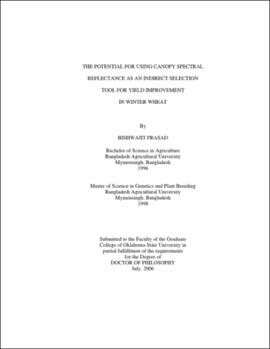| dc.contributor.advisor | Klatt, Arthur R. | |
| dc.contributor.author | Prasad, Bishwajit | |
| dc.date.accessioned | 2013-12-10T18:04:36Z | |
| dc.date.available | 2013-12-10T18:04:36Z | |
| dc.date.issued | 2006-07 | |
| dc.identifier.uri | https://hdl.handle.net/11244/7742 | |
| dc.description.abstract | Scope and Methods of Study: Complementing breeding effort by deploying alternative methods of identifying higher yielding genotypes in a wheat breeding program is important for obtaining greater genetic gains. Spectral reflectance indices (SRI) are one of the many indirect selection tools that have been reported to be associated with different physiological process of wheat. A total of five experiments (a set of 25 released cultivars from winter wheat breeding programs of the U.S. Great Plains and four populations of randomly derived recombinant inbred lines having 25 entries in each population) were conducted in two years under Great Plains winter wheat rainfed environments at Oklahoma State University research farms. Grain yield was measured in each experiment and biomass was measured in three experiments at three growth stages (booting, heading, and grainfilling). Canopy spectral reflectance was measured at three growth stages and eleven SRI were calculated. Correlation (phenotypic and genetic) between grain yield and SRI, biomass and SRI, heritability (broad sense) of the SRI and yield, response to selection and correlated response, relative selection efficiency of the SRI, and efficiency in selecting the higher yielding genotypes by the SRI were assessed. | |
| dc.description.abstract | Findings and Conclusions: The genetic correlation coefficients revealed that the water based near infrared indices (WI and NWI) were strongly associated with grain yield and biomass production. The regression analysis detected a linear relationship between the water based indices with grain yield and biomass. The two newly developed indices (NWI-3 and NWI-4) gave higher broad sense heritability than grain yield, higher direct response to selection compared to grain yield, correlated response equal to or higher than direct response for grain yield, relative selection efficiency greater than one, and higher efficiency in selecting higher yielding genotypes. Based on the overall genetic analysis required to establish any trait as an efficient indirect selection tool, the water based SRI (especially NWI-3 and NWI-4) have the potential to complement the classical breeding effort for selecting genotypes with higher yield potential in a winter wheat breeding program. | |
| dc.format | application/pdf | |
| dc.language | en_US | |
| dc.rights | Copyright is held by the author who has granted the Oklahoma State University Library the non-exclusive right to share this material in its institutional repository. Contact Digital Library Services at lib-dls@okstate.edu or 405-744-9161 for the permission policy on the use, reproduction or distribution of this material. | |
| dc.title | Potential for using canopy spectral reflectance as an indirect selection tool for yield improvement in winter wheat | |
| dc.contributor.committeeMember | Stone, Marvin L. | |
| dc.contributor.committeeMember | Raun, William | |
| dc.contributor.committeeMember | Carver, Brett Frederick | |
| osu.filename | Prasad_okstate_0664D_1915.pdf | |
| osu.accesstype | Open Access | |
| dc.type.genre | Dissertation | |
| dc.type.material | Text | |
| thesis.degree.discipline | Plant and Soil Sciences | |
| thesis.degree.grantor | Oklahoma State University | |
